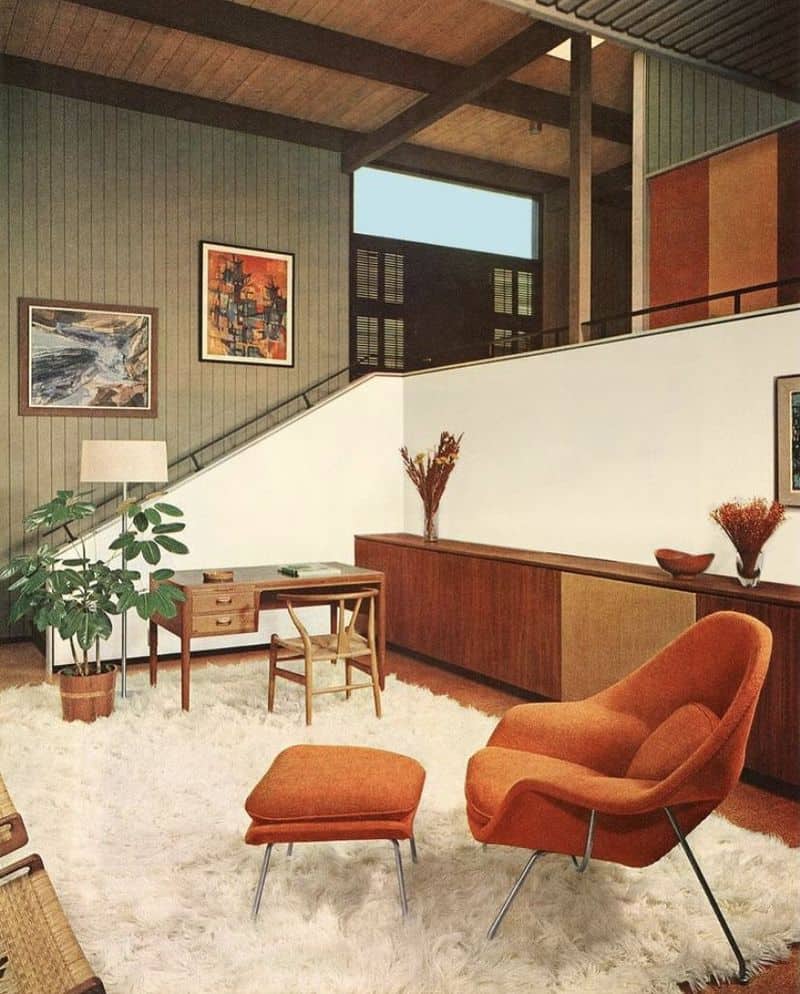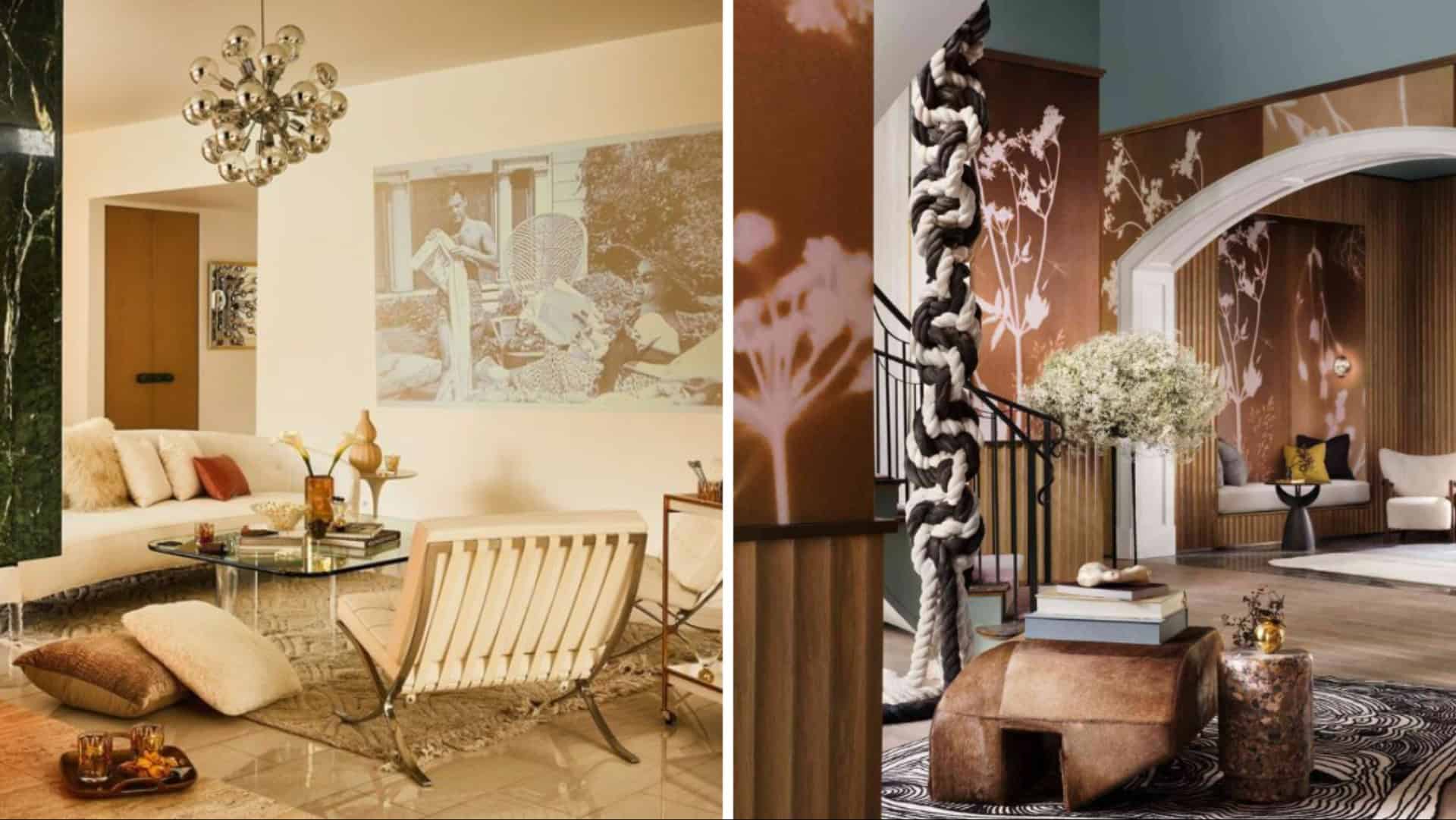Each decade in history brought shifts in cultural norms, technological advancements, and lifestyle preferences.
At the same time, the homeowners’ priorities changed, which affected the way we chose to organize our living spaces.
Let’s go back in time and see what changed in interior layouts from the 1950s to our time.
1. 1950s: Compact Efficiency

The 1950s were characterized by compact, efficient interiors. Homes were built smaller post-war, focusing on functionality.
Living rooms often featured boxy televisions as focal points, surrounded by floral wallpaper and modest furnishings.
Kitchens incorporated colorful Formica countertops, emphasizing easy maintenance.
This era embraced multifunctional furniture, like sofa beds, to maximize space in compact environments.
The interior design of the 50s celebrated simplicity, practicality, and the emergence of consumer culture, reflecting a transition into modern living.
2. 1960s: Open Plan Beginnings

In the 1960s, open-plan living started gaining popularity. Walls began to disappear, creating fluid spaces between living, dining, and kitchen areas.
Bold patterns, vibrant colors, and eclectic decor dominated interiors. The use of iconic pieces like the lava lamp and bean bag chairs reflected the decade’s cultural revolution.
Interiors in the 60s embraced experimentation, breaking away from traditional layouts.
This era marked the beginning of a more casual approach to home life, encouraging social interaction and creative expression.
3. 1970s: Earthy and Eclectic

The 1970s interior design saw a blend of earthy tones and eclectic styles. Spaces were often adorned with wood paneling and shag carpets, creating a cozy yet vibrant atmosphere.
The decade celebrated individuality, mixing vintage and modern elements. Open spaces continued to thrive, with a focus on creating warm, inviting environments.
Plants and boho decor, such as macramé crafts became popular choices.
This eclectic mix mirrored the societal movements of the time, focusing on freedom, self-expression, and a closer connection to nature.
4. 1980s: Bold and Brass

The 1980s brought a bold, glamorous shift in interior design. Homes featured brass accents, glass tables, and pastel colors.
This decade embraced luxury and opulence, with mirrored surfaces and geometric patterns being common. Wall-to-wall carpeting was popular, often in lush, deep tones.
Interiors in the 80s also witnessed a surge in technology, with the integration of personal computers and entertainment systems.
This era reflected a blend of technological advancement and bold, confident design choices.
5. 1990s: Minimalist Approach

The 1990s saw a shift towards minimalist design. Interiors were defined by neutral colors, sleek lines, and an uncluttered feel.
Functionality became key, with an emphasis on creating calm, serene spaces. Open floor plans continued to be popular.
The 90s design focused on practicality, celebrating clean aesthetics and natural materials.
This minimalist approach reflected a desire for tranquility and order amidst the fast-paced lifestyle of the decade.
6. 2000s: The Rise of Technology

The early 2000s marked the rise of technology in home interiors. The integration of computers and flat-screen TVs became standard.
Homes started featuring dedicated home office spaces, reflecting the growing trend of telecommuting.
Modern tech gadgets and smart home devices began to influence layouts, making them more adaptable and multifunctional.
This decade focused on blending technology with comfort, creating spaces that supported a tech-savvy lifestyle while maintaining a homely feel.
7. 2010s: Sustainable Design

The 2010s emphasized sustainable and eco-friendly design. Interiors featured reclaimed wood furniture, energy-efficient lighting, and indoor plants.
This decade focused on reducing environmental impact through sustainable materials and practices. Open-plan layouts remained popular, enhancing natural light and ventilation.
The use of earthy tones and natural textures created warm, inviting spaces. Interiors in the 2010s reflected a growing awareness of sustainability, merging style with responsibility.
This approach promoted harmony between modern living and environmental consciousness.
8. 2020: Multifunctional Spaces

The 2020s brought a need for multifunctional spaces. With more people working from home, interiors adapted to include flexible layouts and modular furniture.
Homes started featuring separate zones for work, relaxation, and entertainment. We put an emphasis on versatility, allowing spaces to transform according to needs.
Open-plan designs continue to evolve, with incorporated technology becoming a natural extension of the interior.
The 2020s interior design embraces practicality and adaptability, reflecting the dynamic lifestyle changes brought by global events.
This era balances functionality with style, creating efficient living environments.

